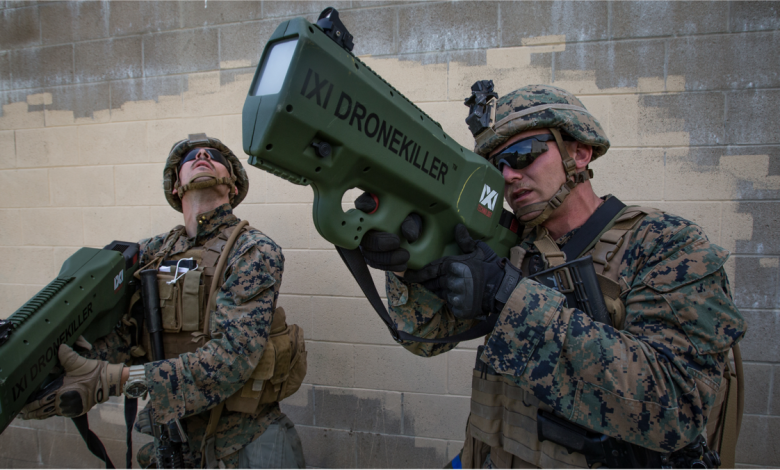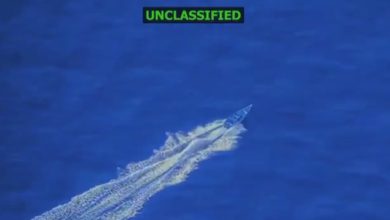Pentagon seeks drone-killing technology that’s safe for civilians

The Pentagon’s Defense Innovation Unit plans to issue a solicitation for low-collateral counter-drone technology next week, part of the second iteration of its Replicator rapid-fielding effort that’s focused on helping the Pentagon protect its installations from small-drone attacks.
DIU Director Doug Beck told House lawmakers Thursday his organization is particularly interested in technologies that can take out drone threats in highly populated areas without major impacts on the environment and, critically, civilians.
“It’s really about those low-collateral interceptors and getting after those solutions — whether it’s through electronic means, kinetic or ballistic means or other forms of bringing those drones down,” Beck told the House Armed Services Tactical Air and Land Forces subcommittee in a hearing.
Replicator’s goal is to create a new pathway for the Pentagon to buy and scale high-need capabilities on faster timelines. Replicator 1, which is ongoing, set out to deliver thousands of low-cost drones by August of this year. Last September, then-Defense Secretary Lloyd Austin announced that the next phase of the effort, dubbed Replicator 2, would center on the small UAS challenge.
DIU is leading Replicator 2 and is partnered closely with the Army-led Joint Counter-Uncrewed Aerial Systems Office, JCO, and the Counter Uncrewed Systems Warfighter Senior Integration Group.
Speaking last week at the Apex Conference, DIU’s chief of Policy Sunmin Kim said that along with its emphasis on low-collateral defeat systems, Replicator 2 is also focused on identifying more affordable systems that are available either commercially or from traditional defense contractors with mature technology.
“We’re interested in low-cost sensing options, so things like passive [radio frequency] radars versus actually using active sensors that we typically do for aircraft,” she said.
Defending against adversarial drones is a significant challenge for the U.S. military and its allies — from attacks in the Red Sea to reports of drone swarms flying over domestic bases.
The Pentagon has launched a number of efforts and organizations over the last few years to address these threats, including the JCO and the Counter Uncrewed Systems Warfighter Senior Integration Group. Last year, the department designated the commanders of U.S. Northern Command and Indo-Pacific Command as “lead synchronizers” for counter-UAS operations. And in December, DOD completed a classified counter-UAS strategy meant to provide a “singular” focus on the most urgent challenges.
Military leaders said Thursday that while the Defense Department is making progress identifying technical solutions and working through complex policies and authorizations, it’s not moving fast enough.
“We’re happy, but we’re not satisfied,” Lt. Gen. Eric Austin, deputy commandant of the Marine Corps for capabilities, development and integration, said during the hearing. “We’re fielding equipment that has the ability and the built-in open architecture to adapt and improve from a software and a hardware perspective, but we’ve got a ways to go to keep up with the threat and exceed that threat.”
Austin highlighted the Marine Air Defense System, or MADIS, which can integrate with the service’s command and control systems and detect and take down small uncrewed aircraft. The Marine Corps also plans to field a prototype this fiscal year of a counter-UAS capability specifically designed to protect dismounted Marines.
“This initiative will put man-portable solutions into Marines’ hands at the tactical edge,” Austin said. “We are feverishly working in belief this will be a model for fielding and iterative improvement.”
Maj. Gen. David Stewart, director of the JCO, and Beck both noted that while DOD has made strides toward identifying and developing counter-UAS technologies, it isn’t buying and fielding those systems in sufficient quantities.
“I believe and assess the capability is there,” Stewart said. “We have a bit of a capacity problem across each of the services.”
Beck noted that for the services to fill those capacity gaps, they need more resources, authorities and funding flexibility from Congress.
“We need to be doing much, much more,” he said. “We must put capability in place now. We must dramatically improve our capacity and speed to update unmanned and counter-unmanned technologies. We must build the muscle to do so at greater and greater scale.”
Courtney Albon is C4ISRNET’s space and emerging technology reporter. She has covered the U.S. military since 2012, with a focus on the Air Force and Space Force. She has reported on some of the Defense Department’s most significant acquisition, budget and policy challenges.







